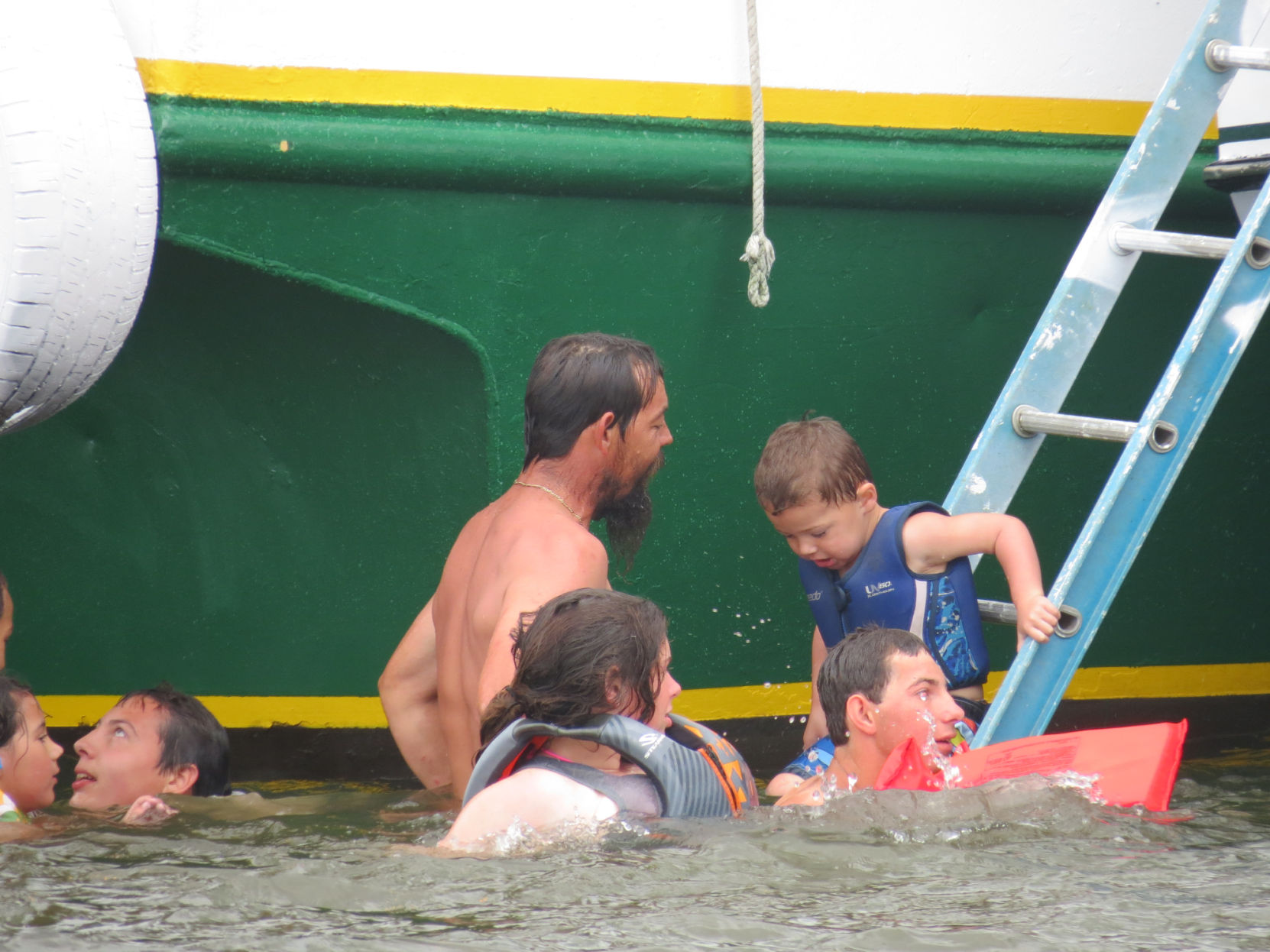
LSU softball wins; heading to CWS
May 27, 2015
House budget spares higher ed, but slams state’s uninsured
May 27, 2015From Grand Isle to Grand Caillou and beyond, recent deaths of youngsters due to drowning have provided sad punctuation to long-standing warnings from safety experts and first-responders, who maintain that too much caution is never enough.
“You have to think safety,” was the concise answer given by Maj. Tommy Odom of the Terrebonne Parish Sheriff’s Office, who as its Water Patrol commanding officer has dealt with too many bereaved families in his years of service, when asked about the lessons learned from tragedy.
The most recent victim was 16-year-old Travon Robertson of Pontchatoula. He was reported missing Sunday, after venturing onto the slippery rock jetties that extend from Grand Isle State Park. A call was received by the Coast Guard at about 2:15 p.m. that the teen disappeared after swimming from a jetty to a piling.
His body was recovered Monday; Grand Isle Police Chief Euris DuBois said the precise circumstances are still under investigation.
In Terrebonne Parish questions persist about the May 16 death of six-year-old Allen Joseph Verdin in a relative’s pool. Although adults were nearby, there is evidence, according to Allen’s mom, who was not present, that they may have depended on older children to watch for the little ones.
It was Allen’s seven-year-old brother, Walter, who first saw him floating at the far end.
“Walter had gotten out of the pool and he had to jump back in and he said to me later ‘I don’t know how to swim but I did,’” said a grieving Jacqueline Verdin, who buried her son last week. “Walter and his little cousins and a friend from school started pulling on Allen to get him out.”
The child’s death – on the heels of an official declaration of pool safety month by Terrebonne Parish’s government days before it occurred – underscores the risks that exist when children and water mix, say safety advocates and local officials.
Now that the summer season is in full swing, with schools out and children spending more time outdoors in pools, boats and beside or in water bodies, authorities and medical experts say they can’t emphasize enough the danger potential. Attempts to legislate safeguards have failed in local communities; safety experts say the onus for safety still falls on parents, and stress that even a few seconds spent with eyes off of frolicking, sometimes rough-housing children can be too long.
Undeniably clear is the fact that Allen Verdin’s death is one more bolster for a long-standing statistic from the U.S. Centers for Disease Control and Prevention, which says that drowning is the second-leading cause of death for children under age 15.
LACHRYMOSE LEGACY
The sorrow wrought by child drownings is well known in Terrebonne Parish, where a vigil is held for victims each year in June.
Just a week before Allen’s death, the parish council had declared June to be “Hayden’s Swimming Pool Safety Awareness Month.”
It is named for 2-year-old Hayden Paul Davenport, who entered an unattended Houma swimming pool in 2007 and, in the words of the council’s initial resolution, “became another statistic in the tragic list of infant drowning victims throughout this country.”
Another child, Lauren Gros, died of drowning the following year.
The irony was not lost on Councilwoman Beryl Amedee, when she learned that Allen died so close to the annual re-dedication for public awareness.
“That was my first thought, that within the same week that we declared pool safety month, we declare it every year for awareness, to promote awareness,” Amedee said. “Learning that we have just lost another little one my heart just breaks.”
The council – before Amedee’s time – had grappled with the question of how better to prevent drowning, particularly in pools. A requirement for a 4-foot fence around pools was discussed and tabled, but never acted upon.
Hayden’s mom, Stephanie Thibodeaux, lobbied hard for the law. The council, ultimately, didn’t want to tell people what to do with their property and so the attempt failed. Thibodeaux asked for a law to protect children and got an annual candlelight vigil instead.
Insurance companies do require fences around pools, but not every home is insured and not every insured home necessarily follows those requirements.
That a parish publicly shied from a fence requirement is a point moot in the case of little Allen, who was already in the pool and, to the best anyone could figure at the time, under some form of supervision.
Precise circumstances surrounding the death of Allen, a gentle, loving child with a beatific smile, are still in disarray. Details of the drowning, classified by authorities as accidental, are a mere mosaic of recollections from panicked children.
MULTIPLE VENUES
Details behind overall national statistics are grim.
According to the Centers for Disease Control, one in five people who die from drowning overall are children 14 and younger. For every child who dies from drowning, another five receive emergency department care for nonfatal submersion injuries. Half of those require hospitalization or further care, in many cases due to “severe brain damage that may result in long-term disabilities such as memory problems, learning disabilities, and permanent loss of basic functioning,” or, as a CDC statement puts it, “a permanent vegetative state.”
Pools are an important risk factor, but other venues offer threats as well.
“We are a coastal parish,” Amedee said. “We have the bayous, we have drainage ditches. Children have drowned or almost drowned in rainfall ditches. We are surrounded by water.”
On April 14 in Lafourche Parish, not far from Ochsner St. Anne Hospital, 3-year-old Remy Dufrene was swept away in a drainage canal following heavy rains.
“Deputies responded and learned that a 3-year-old was playing outside in the back yard and when the child’s caretaker went out to retrieve him and upon calling out to him, the child ran and fell into the ditch,” a statement from Sheriff Craig Webre reads. “Immediate efforts to retrieve him were unsuccessful.”
A 15-minute search ensued, with the boy’s father locating him in a clump of weeds about 75 yards downstream. The toddler was rushed to the hospital where he later died.
“During times such as these, words are hard to come by which can express our deep sorrow for the loss of a young life,” Webre said.
CONFLICT IN USAGE
Another threat comes from retention ponds, now required for most new subdivisions and commercial properties.
The Terrebonne Parish Council had discussed requiring fencing around retention ponds, but a difficult issue arose.
Because the retention ponds are required, some developers chose to make them part of the landscape, and a selling point for their properties. Residents, they reasoned, could see the ponds – especially if stocked with fish – as a bonus.
“It is unfair to require someone to fence this pond, I am much more in favor of increasing water safety and awareness,” Amedee said. “For developers who are including these ponds as an asset that would increase property values, to start putting a fence around it would be counterproductive.”
Amedee has addressed school board officials, suggesting that swimming classes be made part of the available curriculum. But so far, no such action has been taken. The YMCA offers swimming lessons, but Amedee noted that the cost could be prohibitive for some families.
SAFETY FIRST
“I don’t personally know where to direct people to get swimming lessons and I would like to do a better job at promoting something where everyone can go,” she said. “With many public pools having been closed I am not sure there is a whole lot of opportunity.”
Officials who routinely deal with death generally agree that pools pose a particularly great risk, because they are regarded as safe, a part of one’s home, and because no matter how watchful parents or other responsible adults might be, the window of time within which a child can die or become seriously injured is no wider than the seconds taken to answer a phone call.
Experts also say that drowning victims – adults or children – do not always thrash or struggle. A victim can just disappear without a sound or sign.
“It’s never the child’s fault. It’s the adults,” said Mark Goldman, chief investigator for Dr. John King, the coroner of Lafourche Parish. Goldman says through his career, in both Terrebonne and Lafourche parishes, he has seen too many child drownings. “I have five grandchildren under the age of 3. I have a 6-foot fence, a pole and all the safety equipment. For some reason, the local governments don’t want to force people to have fences or gates. A pool is an attraction and it will attract a child to jump a fence when nobody is there. There are problems anytime a parent is not watching a child, supervising.”
Some safety advocates suggest that within a group of adults one person be assigned to monitor the pool activities non-stop for a given period, then pass off the duty to another adult.
“It is impossible for one person to watch three kids at a time no less five at one time,” Goldman said. “In most of the cases I have had a parent was not watching or not knowing the child was in the pool.”
Children and adults frolic in the waters of Lake Boudreaux beside an anchored boat during this year’s annual blessing of the fleet in Chauvin. Children in this photo are wearing proper flotation devices as recommended by the Coast Guard and other agencies. Plastic floats and other toys, experts note, are not substitutes for proper safety devices in pools nor in outdoor bayou or lake settings.













